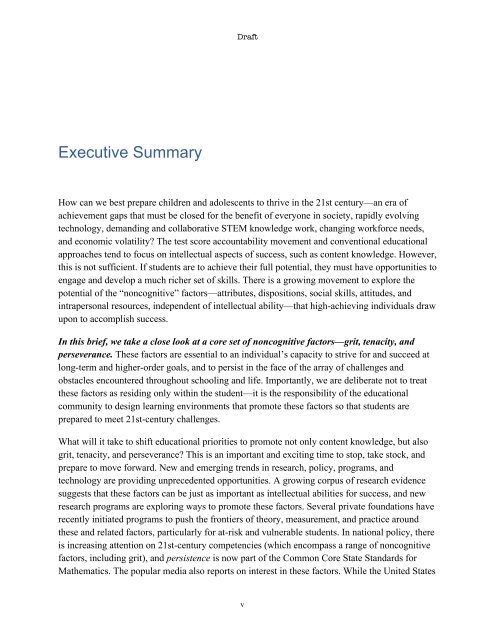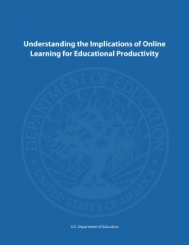Promoting Grit, Tenacity, and Perseverance - U.S. Department of ...
Promoting Grit, Tenacity, and Perseverance - U.S. Department of ...
Promoting Grit, Tenacity, and Perseverance - U.S. Department of ...
You also want an ePaper? Increase the reach of your titles
YUMPU automatically turns print PDFs into web optimized ePapers that Google loves.
Draft<br />
Executive Summary<br />
How can we best prepare children <strong>and</strong> adolescents to thrive in the 21st century—an era <strong>of</strong><br />
achievement gaps that must be closed for the benefit <strong>of</strong> everyone in society, rapidly evolving<br />
technology, dem<strong>and</strong>ing <strong>and</strong> collaborative STEM knowledge work, changing workforce needs,<br />
<strong>and</strong> economic volatility? The test score accountability movement <strong>and</strong> conventional educational<br />
approaches tend to focus on intellectual aspects <strong>of</strong> success, such as content knowledge. However,<br />
this is not sufficient. If students are to achieve their full potential, they must have opportunities to<br />
engage <strong>and</strong> develop a much richer set <strong>of</strong> skills. There is a growing movement to explore the<br />
potential <strong>of</strong> the “noncognitive” factors—attributes, dispositions, social skills, attitudes, <strong>and</strong><br />
intrapersonal resources, independent <strong>of</strong> intellectual ability—that high-achieving individuals draw<br />
upon to accomplish success.<br />
In this brief, we take a close look at a core set <strong>of</strong> noncognitive factors—grit, tenacity, <strong>and</strong><br />
perseverance. These factors are essential to an individual’s capacity to strive for <strong>and</strong> succeed at<br />
long-term <strong>and</strong> higher-order goals, <strong>and</strong> to persist in the face <strong>of</strong> the array <strong>of</strong> challenges <strong>and</strong><br />
obstacles encountered throughout schooling <strong>and</strong> life. Importantly, we are deliberate not to treat<br />
these factors as residing only within the student—it is the responsibility <strong>of</strong> the educational<br />
community to design learning environments that promote these factors so that students are<br />
prepared to meet 21st-century challenges.<br />
What will it take to shift educational priorities to promote not only content knowledge, but also<br />
grit, tenacity, <strong>and</strong> perseverance? This is an important <strong>and</strong> exciting time to stop, take stock, <strong>and</strong><br />
prepare to move forward. New <strong>and</strong> emerging trends in research, policy, programs, <strong>and</strong><br />
technology are providing unprecedented opportunities. A growing corpus <strong>of</strong> research evidence<br />
suggests that these factors can be just as important as intellectual abilities for success, <strong>and</strong> new<br />
research programs are exploring ways to promote these factors. Several private foundations have<br />
recently initiated programs to push the frontiers <strong>of</strong> theory, measurement, <strong>and</strong> practice around<br />
these <strong>and</strong> related factors, particularly for at-risk <strong>and</strong> vulnerable students. In national policy, there<br />
is increasing attention on 21st-century competencies (which encompass a range <strong>of</strong> noncognitive<br />
factors, including grit), <strong>and</strong> persistence is now part <strong>of</strong> the Common Core State St<strong>and</strong>ards for<br />
Mathematics. The popular media also reports on interest in these factors. While the United States<br />
v
















